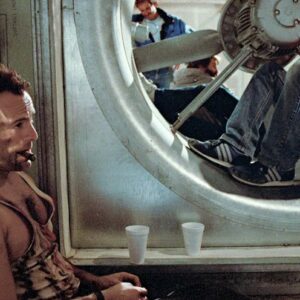When we think of Bruce Willis, our minds often jump to his iconic on-screen roles, such as John McClane in Die Hard or Dr. Malcolm Crowe in The Sixth Sense. These performances have cemented Willis as a cinematic legend, renowned for his ability to portray tough, complex characters. However, beyond his action-packed performances and gripping drama roles, Willis has also made a significant impact in the world of voice acting. His unique vocal presence and ability to convey emotion have brought a variety of animated characters to life, showcasing his versatility as an actor in a different yet equally challenging medium.
Section 1: The Transition from Screen to Voice
Bruce Willis’s transition into voice acting was a natural progression in his illustrious career. As an actor, Willis has always possessed a voice that carries both grit and warmth, a combination that resonates deeply with audiences. This unique vocal quality allowed him to seamlessly move into the world of animation, where voice alone must carry the weight of character development. In a medium where physical expressions are absent, the voice must be potent enough to convey the full spectrum of emotions, from joy to sorrow, from anger to fear. Willis’s voice, with its gravelly texture and inherent gravitas, was perfectly suited to this task.
Voice acting differs significantly from on-screen acting in that it requires actors to create a character’s entire persona without the aid of visual cues. For Willis, this meant tapping into his deep well of acting skills to ensure that every line delivered in the recording booth was imbued with the appropriate emotional weight. His transition from screen to voice was not merely a shift in medium but a testament to his adaptability and commitment to the craft of acting in all its forms. By stepping into the world of animation, Willis expanded his repertoire, proving that his talents were not confined to the physicality of live-action performances but also thrived in the realm of voice.
Section 2: Memorable Roles in Animation
Bruce Willis’s voice acting portfolio, though not as extensive as his live-action filmography, includes several memorable roles that have left a lasting impact on audiences. One of his most notable voice acting roles was in the animated feature Over the Hedge (2006), where he voiced the clever and charismatic raccoon, RJ. The film, based on the comic strip of the same name, features RJ as the central character, a street-smart raccoon who concocts a plan to raid the food supplies of suburban humans. Willis brought RJ to life with a blend of charm and cunning, perfectly capturing the character’s mischievous yet endearing nature.
What made RJ a standout character was Willis’s ability to infuse him with a complex personality. RJ is not a typical animated protagonist; he is flawed, selfish at times, but ultimately redemptive. Willis’s performance balanced humor with a touch of vulnerability, making RJ relatable and likable despite his flaws. The subtlety with which Willis conveyed RJ’s internal struggles and eventual growth as a character is a testament to his skill as a voice actor. His performance in Over the Hedge is often cited as one of the highlights of the film, contributing significantly to its critical and commercial success.
Another significant role in Willis’s voice acting career was his work as Spike the dog in Rugrats Go Wild (2003). Although Spike is a non-verbal character in the original Rugrats series, Rugrats Go Wild gave him a voice—one that perfectly captured the essence of the beloved character. In this role, Willis faced the unique challenge of voicing a character that had never spoken before. Despite Spike’s limited dialogue, Willis’s performance was filled with emotion and nuance, allowing the audience to connect with Spike on a deeper level. His voice work here demonstrated his skill in conveying complex feelings through simple, yet effective, vocal expressions.
In Rugrats Go Wild, Willis managed to capture the loyalty, protectiveness, and slight goofiness that fans had always imagined Spike to possess. The film’s narrative allowed Spike to express his thoughts, and Willis ensured that these thoughts were voiced with the same warmth and humor that characterized the original non-verbal version of the character. This role showcased Willis’s ability to adapt to different types of characters, proving that he could bring the same level of dedication to a canine character as he did to human ones.
Section 3: The Art of Voice Acting
Voice acting requires a different set of skills than traditional on-screen acting. Without the aid of physical expressions or body language, actors like Bruce Willis must rely solely on their voice to communicate a character’s personality, emotions, and motivations. This reliance on voice alone to convey everything about a character makes voice acting a particularly challenging art form. For Willis, the challenge was not only to match his past performances but to bring something new to the table in every voice role he took on.
In the world of animation, the voice must carry the entire emotional weight of the character. This means that the actor’s vocal delivery must be incredibly precise, conveying not just words, but the subtleties of tone, pacing, and emotion that bring a character to life. Willis’s voice acting performances are a testament to his ability to adapt and excel in this medium. He brings the same intensity and commitment to his voice roles as he does to his live-action performances, making each character he portrays feel authentic and fully realized.
One of the key elements of voice acting is the ability to convey a wide range of emotions through vocal inflection. Willis excels in this area, using his voice to evoke everything from humor to pathos. In Over the Hedge, for example, his portrayal of RJ required him to oscillate between being a smooth-talking trickster and a vulnerable character seeking redemption. Willis handled these shifts with ease, ensuring that RJ’s emotional journey was clear and compelling.
Moreover, voice acting requires a deep understanding of the character being portrayed, as well as the ability to translate that understanding into vocal performance. Willis’s success in this field is largely due to his ability to inhabit his characters fully, even when working in the confines of a recording booth. His performances are never just about reading lines; they are about embodying the character, giving them depth, and making them memorable for audiences of all ages.
Section 4: The Impact on the Industry
Bruce Willis’s success in voice acting has not only expanded his career but has also contributed to the broader appreciation of voice acting as a craft. His work has helped to elevate animated films, proving that they can be just as emotionally engaging and artistically significant as live-action movies. For many viewers, his voice performances have left a lasting impression, further solidifying his status as a versatile and talented actor.
Voice acting is often underappreciated in comparison to live-action performances, but actors like Willis have helped to change that perception. His involvement in high-profile animated projects has brought greater attention to the importance of voice work in the entertainment industry. By lending his voice to animated characters, Willis has demonstrated that voice acting is not a secondary form of performance but a powerful medium in its own right.
The success of films like Over the Hedge and Rugrats Go Wild owes much to Willis’s contributions. His performances helped these films resonate with audiences, showing that a well-crafted voice performance can elevate an animated character to iconic status. Furthermore, his work in these films has inspired other actors to explore voice acting, contributing to the growing recognition of the art form.
In addition to his impact on individual films, Willis’s voice acting has also influenced the broader animation industry. His involvement in these projects has shown that A-list actors can bring a new level of depth and authenticity to animated characters, encouraging other filmmakers to cast top-tier talent in their animated projects. This trend has led to a new era of animated films where the quality of voice acting is seen as just as important as the animation itself.
Section 5: The Technical Side of Voice Acting
While the artistry of voice acting is paramount, the technical aspects of the craft are equally important. For Bruce Willis, mastering the technical side of voice acting was essential to delivering the high-quality performances that audiences have come to expect from him. Voice acting involves working closely with sound engineers, directors, and other professionals to ensure that the final product is polished and effective.
One of the technical challenges of voice acting is maintaining consistency in vocal delivery. Unlike live-action performances, which are filmed in sequence, voice acting sessions often involve recording lines out of order. This means that actors must be able to maintain the same emotional tone and vocal quality across different sessions, ensuring that the character’s voice remains consistent throughout the film. Willis’s professionalism and attention to detail have allowed him to navigate these challenges with ease, delivering performances that are both consistent and emotionally resonant.
Another technical aspect of voice acting is the ability to adapt to different recording environments. Voice actors often work in a variety of settings, from professional recording studios to makeshift booths set up on location. Willis’s experience in the film industry has equipped him with the skills needed to perform in these diverse environments, ensuring that his voice work is always of the highest quality, regardless of the recording conditions.
In addition to these challenges, voice actors must also be able to take direction and adjust their performances on the fly. In the recording booth, directors may ask for multiple takes of the same line, each with a slightly different delivery. This requires actors to be highly adaptable, able to tweak their performances to meet the director’s vision. Willis’s experience in live-action films, where he has worked with some of the industry’s top directors, has made him particularly adept at responding to direction and delivering the desired performance.
Section 6: Legacy and Influence
Bruce Willis’s contributions to the world of voice acting have left a lasting legacy. His performances have not only brought animated characters to life but have also elevated the status of voice acting within the entertainment industry. By lending his voice to iconic characters, Willis has shown that voice acting is a vital and respected aspect of the acting profession.
Willis’s influence can be seen in the increasing number of high-profile actors who have followed in his footsteps, taking on voice roles in animated films and television shows. His success in this field has helped to break down the barriers between live-action and voice acting, encouraging more actors to explore the possibilities of this medium.
Furthermore, Willis’s voice acting has had a significant impact on audiences. His performances have resonated with viewers of all ages, from children who grew up watching Over the Hedge to adults who appreciated the depth and nuance he brought to his roles. These performances have become a part of the cultural fabric, with many of Willis’s voice roles continuing to be beloved by fans around the world.
Section 7: The Future of Voice Acting and Bruce Willis’s Role
As the animation industry continues to evolve, voice acting will likely play an increasingly important role in bringing stories to life. With advancements in technology and the growing popularity of animated content, the demand for skilled voice actors is higher than ever. Bruce Willis’s contributions to the field have helped pave the way for future generations of voice actors, setting a standard for excellence in the industry.
Looking ahead, it is clear that Willis’s influence on voice acting will continue to be felt for years to come. His ability to bring characters to life through his voice has set a high bar for future performers, and his work will undoubtedly inspire new talent to explore the possibilities of voice acting. As animated films and television shows continue to captivate audiences worldwide, Willis’s legacy as a pioneer in the field will remain an integral part of the industry’s history.
Conclusion
Bruce Willis’s voice acting career may not be as widely recognized as his on-screen roles, but it is an integral part of his legacy. Through his distinctive voice and expressive delivery, he has brought a range of animated characters to life, adding depth and personality to every role. Whether he’s playing a scheming raccoon, a loyal dog, or any other character, Willis’s voice acting continues to resonate with audiences, showcasing his remarkable ability to bring characters to life in any medium.
In a world where animation is becoming an increasingly important part of the entertainment landscape, Bruce Willis’s contributions to the field of voice acting are more relevant than ever. His performances have not only entertained audiences but have also helped to elevate the art of voice acting to new heights. As we look back on his career, it is clear that Willis’s voice will continue to echo through the world of animation, leaving a lasting impression on generations to come.





